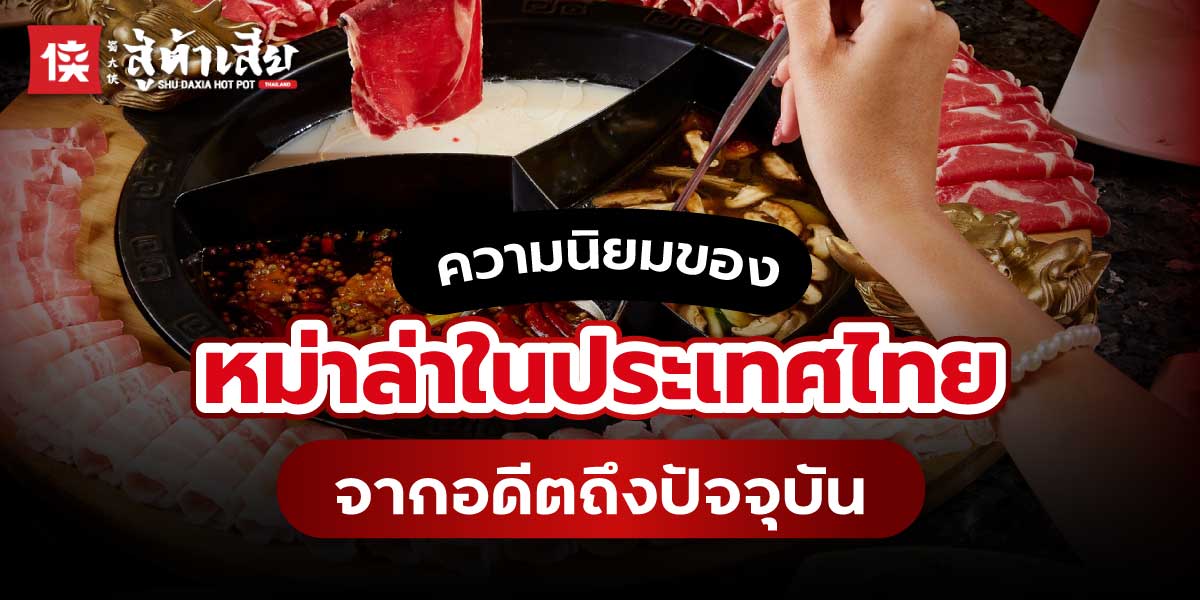หม่าล่าเป็นอีกหนึ่งเมนูอาหารยอดนิยมในประเทศไทยที่ได้รับอิทธิพลมาจากประเทศจีน ด้วยรสชาติที่โดดเด่นและเป็นเอกลักษณ์อย่างความเผ็ดร้อน ควบคู่กับความรู้สึกชาในช่องปาก ซึ่งเป็นรสชาติที่คนไทยไม่ค่อยได้สัมผัสบ่อยครั้ง จึงไม่แปลกเลยที่ในปัจจุบัน กระแสของหม่าล่าจะเพิ่มสูงขึ้นอย่างต่อเนื่อง ทั้งหม่าล่าปิ้งย่าง หม่าล่าหม้อไฟ หรืออีกหนึ่งประเภทที่เพิ่งเข้าสู่ประเทศไทยอย่าง ‘หม่าล่าสายพาน’ เรียกได้ว่านอกจากความอร่อยแล้ว ยังมีความท้าทายและความแปลกใหม่เพิ่มขึ้นมาอีกด้วย
ทำความรู้จัก อาหารยอดนิยมจากประเทศจีน

หลายคนยังเข้าใจผิดว่าหม่าล่า (Mala) หมายถึงเมนูอาหารที่นำเนื้อสัตว์หรือวัตถุดิบต่าง ๆ มาเสียบไม้แล้วนำไปปิ้งหรือย่าง แต่จริง ๆ แล้วไม่ถูกทั้งหมด เพราะหม่าล่าหมายถึงรสชาติของอาหารที่มีความเผ็ดร้อนและชาลิ้น โดยในภาษาจีนคำว่า หม่า แปลว่า ‘ชา’ และคำว่าล่า แปลว่า ‘เผ็ด’ นั่นเอง ซึ่งก่อนที่นำกลายมาเป็นหม่าล่านี้ จะมีการนำพริกฮวาเจียว (Sichuan Pepper) และเครื่องเทศอื่น ๆ ไปเคี่ยวรวมกันในน้ำมันเป็นเวลานานจนได้ที่ ถึงกลายมาเป็นพริกหม่าล่าเหมือนที่เรารู้จักกัน
โดยเหตุผลที่ว่าทำไมคนไทยถึงเรียกเนื้อเสียบไม้ว่า ‘หม่าล่า’ เป็นเพราะว่ากระแสหม่าล่าครั้งแรกที่เริ่มเข้ามาในประเทศไทยเป็นเนื้อเสียบไม้และทาผงพริก ก่อนจะนำไปย่าง จนกลายมาเป็นคำเรียกติดปากว่า ‘หม่าล่า’ อย่างไรก็ตามในปัจจุบันไม่เพียงเนื้อเสียบไม้เท่านั้น แต่หม่าล่าได้ถูกนำไปปรุงเป็นอาหารหลากหลายประเภท ทั้งซุปหม้อไฟหม่าล่า ปิ้งย่างหม่าล่า หรือการผสมผสานระหว่างอาหารไทยและหม่าล่าเข้าด้วยกันก็มีมากขึ้นเรื่อย ๆ
หม่าล่า เมนูยอดฮิตในประเทศไทย
หากพูดถึงกระแสหม่าล่าฟีเวอร์ ต้องย้อนกลับไปในปี 2018 โดยจุดเริ่มต้นคือ ร้านอาหารหม่าล่าหม้อไฟจากประเทศจีนเข้ามามีตีตลาดร้านอาหารในประเทศไทย ซึ่งได้รับกระแสการตอบรับอย่างล้นหลามตั้งแต่วันแรกที่เปิด ทำให้ลูกค้าพูดกันปากต่อปาก รวมทั้งรีวิวอาหารบนสื่อต่าง ๆ จนเริ่มมีร้านอาหารหม่าล่าเปิดให้บริการมากขึ้นอย่างต่อเนื่อง รวมไปถึงแบรนด์ร้านอาหารมากมายที่ทนกระแสหม่าล่าฟีเวอร์ไม่ไหวก็หันมาเข้าร่วม โดยการนำเมนูหม่าล่าเข้าไปอยู่ในเมนูอาหารของร้านด้วย
แต่กระนั้น ก่อนที่กระแสหม่าล่าชาบู หรือหม่าล่าสายพานจะได้รับความนิยมจากผู้บริโภคอย่างแพร่หลาย หม่าล่าปิ้งย่าง หรือปิ้งย่างเสียบไม้เป็นเมนูแรกที่เข้ามาในประเทศไทย ซึ่งได้รับการตอบรับอย่างดี จนมีร้านหม่าล่าปิ้งย่างเปิดให้บริการมากขึ้นเรื่อย ๆ โดยการใช้วัตถุดิบต่าง ๆ ที่แตกต่างกันออกไป ทั้งเนื้อสัตว์จำพวก หมูสามชั้น หรือเนื้อไก่ รวมถึงผัก ไม่ว่าจะเป็นผักกาดขาว เห็ดเข็มทอง หรือข้าวโพดอ่อน เป็นต้น นำมาเสียบไม้และย่าง ก่อนจะมาขายไม้ละ 5 – 10 บาทตามความเหมาะสมนั่นเอง
ทำไมรสชาติของหม่าล่าถึงถูกปากคนไทย

ต้องบอกไว้เลยว่าวัฒนธรรมด้านอาหารของประเทศไทยมีความหลากหลายเป็นอย่างมาก เพราะประเทศไทยแบ่งออกเป็น 4 ภาคหลัก ๆ คือ ภาคใต้ ภาคเหนือ ภาคอีสาน และภาคกลาง ซึ่งแต่ละภาคก็มีรสชาติอาหารที่เป็นเอกลักษณ์แตกต่างกันไป จึงทำให้คนไทยคุ้นชินกับการรับประทานอาหารหลากหลายรสชาติ อีกทั้งคนไทยยังนิยมใช้สมุนไพรที่มีกลิ่นเฉพาะตัวในการปรุงอาหารต่าง ๆ ไม่ว่าจะเป็นขิง ข่า ตะไคร้ มะกรูด หรือมะแขว่นที่มีรสชาติเผ็ดร้อนชาลิ้นใกล้เคียงกับพริกฮวาเจียว
ด้วยปัจจัยดังกล่าวนี้ เมื่อรวมเข้ากับรสชาติของหม่าล่าที่มีความเผ็ดร้อน และชาลิ้นที่โดดเด่นเป็นเอกลักษณ์เฉพาะตัว ทั้งยังมีกลิ่นหอม ชวนน่ารับประทาน จึงไม่แปลกเลยที่หม่าล่าจะสามารถครองใจคนไทยได้ตั้งแต่ครั้งแรกที่ลิ้มลอง จนกลายมาเป็นอีกหนึ่งเมนูยอดเยี่ยมที่ไม่ควรพลาด อย่างไรก็ตาม การรับประทานหม่าล่าควรอยู่ในปริมาณที่พอดี ไม่มากและบ่อยจนเกินไป เพื่อหลีกเลี่ยงผลกระทบของร่างกายที่อาจตามมาในอนาคต รวมไปถึงคนที่ไม่ชอบรสชาติเผ็ด หรือทานเผ็ดมากไม่ได้ ไม่ควรรับประทานหม่าล่าอย่างเด็ดขาด
บทสรุป
ปัจจุบันไม่ว่าจะไปที่ไหนก็จะเห็นร้านอาหารหม่าล่าอยู่เต็มไปหมด ไม่ว่าจะเป็นหม่าล่าหม้อไฟ หม่าล่าปิ้งย่าง หรือชาบูหม่าล่า เป็นต้น แทบจะเรียกได้ว่าเป็นเมนูอาหารอันดับหนึ่งที่ชาวไทย รวมทั้งชาวต่างชาติที่อยู่ในประเทศไทยชื่นชอบและนิยมรับประทานเลยก็ว่าได้ ด้วยรสชาติที่จัดจ้าน เผ็ดชาแบบที่อาหารในประเทศไทยไม่มี จึงกลายมาเป็นสุดยอดอาหารที่ได้รับความนิยมมากที่สุดในประเทศไทย
สำหรับใครที่เป็นสายหม่าล่า ต้องห้ามพลาดกับร้าน Shu Daxia หม้อไฟหม่าล่าต้นตำรับจากเมืองเฉิงตู ประเทศจีน ตอบโจทย์ทุกความต้องการในการรับประทานหม่าล่าอย่างแน่นอน ด้วยวัตถุดิบระดับพรีเมียม พร้อมบรรยากาศการแตกแต่งภายในร้านด้วยสไตล์จีนย้อนยุค และบริการที่น่าประทับใจ หากใครสนใจสามารถติดตามรายละเอียดเพิ่มเติมได้ที่เว็บไซต์ หรือจองคิวที่เบอร์ 094-491-3900 และช่องทางการติดต่ออื่น ๆ ของ Shu Daxia
